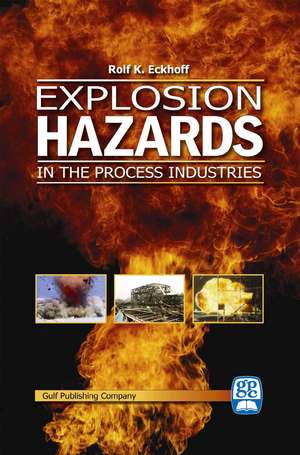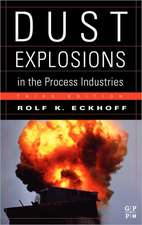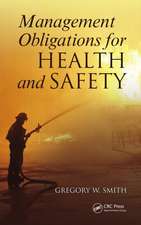Explosion Hazards in the Process Industries
Autor Rolf K. Eckhoffen Limba Engleză Hardback – oct 2005
| Toate formatele și edițiile | Preț | Express |
|---|---|---|
| Paperback (1) | 707.16 lei 36-50 zile | |
| ELSEVIER SCIENCE – 14 iun 2016 | 707.16 lei 36-50 zile | |
| Hardback (1) | 919.31 lei 43-57 zile | |
| ELSEVIER SCIENCE – oct 2005 | 919.31 lei 43-57 zile |
Preț: 919.31 lei
Preț vechi: 1259.32 lei
-27% Nou
Puncte Express: 1379
Preț estimativ în valută:
175.97€ • 191.20$ • 147.91£
175.97€ • 191.20$ • 147.91£
Carte tipărită la comandă
Livrare economică 21 aprilie-05 mai
Preluare comenzi: 021 569.72.76
Specificații
ISBN-13: 9780976511342
ISBN-10: 0976511347
Pagini: 436
Ilustrații: b/w illus & photos
Dimensiuni: 164 x 236 x 33 mm
Greutate: 0.86 kg
Editura: ELSEVIER SCIENCE
ISBN-10: 0976511347
Pagini: 436
Ilustrații: b/w illus & photos
Dimensiuni: 164 x 236 x 33 mm
Greutate: 0.86 kg
Editura: ELSEVIER SCIENCE
Cuprins
Preface
About the Author
1 Introduction
1.1 Process Safety—a Persistent Challenge to Educators
1.2 What is an Explosion?
1.3 Accidental Explosions—a Real Hazard in the Process Industries
1.4 Basic Differences in How and Where Explosive Gas, Spray/Mist, and Dust Clouds are Likely to Be Generated
1.5 European Union Definition of Explosive Atmospheres
1.6 The “Human Factor
2 Gas and Vapor Cloud Explosions
2.1 Combustion of Gases and Vapors
2.2 Ignition of Premixed Gas/Vapor and Air
2.3 Case Histories of Accidental Gas/Vapor Cloud Explosions
2.4 Means of Preventing and Mitigating Gas/Vapor Explosions in the Process Industries
3 Explosions in Clouds of Liquid Droplets in Air (Spray/Mist)
3.1 Introduction
3.2 Generation of Clouds Liquid Droplets in Air (Spray/Mist)
3.3 Combustion of Clouds of Liquid Droplets in Air (Spray/Mist)
3.4 Ignition of Clouds of Liquid Droplets in Air (Spray/Mist)
3.5 Case Histories of Spray/Mist Explosions
3.6 Means of Preventing and Mitigating Spray/Mist Explosions in the Process Industries
4 Gas and Dust Explosions Caused by Smoldering Combustion in Powder Layers and Deposits
4.1 Combustion Velocities/Rates in Powder Layers/Deposits
4.2 Initiation of Combustion in Powder/Dust Layers and Deposits
4.3 Explosion Initiation Processes by Smoldering/Glowing Material
4.4 Case Histories of Accidental Smoldering Combustion in Silos, Resulting in Gas Explosions, and Adopted Extinction Procedures
4.5 Measures for Preventing Excessive Self-Heating in Silos
5 Dust Explosions
5.1 What is a Dust Explosion?
5.2 Combustion of Dust Clouds in Air
5.3 Ignition of Dust Clouds in Air
5.4 Case Histories of Dust Explosions
5.5 Means of Preventing and Mitigating Dust Explosions in the Process Industries
6 Explosives, Pyrotechnics, and Propellants
6.1 Chemical Composition of Some Explosives
6.2 Combustion Propagation in Explosives/Pyrotechnics/Propellants
6.3 Ignition/Initiation of Explosives/Pyrotechnics/Propellants
6.4 Case Histories of Accidental Explosives/Pyrotechnics/Propellants Explosions
6.5 Measures for Preventing and Mitigating Accidental Explosions of Explosives, Propellants, and Pyrotechnics
7 Design of Electrical Apparatuses for Hazardous Areas
7.1 Classification of Hazardous Areas
7.2 Basic Design Concepts for Electrical Apparatus
8 Outline of Methods for Hazard and Risk Analysis
8.1 Introduction
8.2 Hazard Surveys or Inventories
8.3 Hazard and Operability Studies (HAZOP) and Failure Modes and Effects Analysis (FMEA)
8.4 Analysis of Systems Reliability by Fault Tree Analysis
8.5 Quantitative Risk Analysis by Event Tree Analysis
8.6 Safety Audits
References
Index









